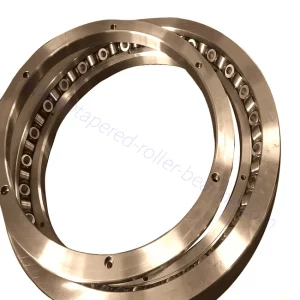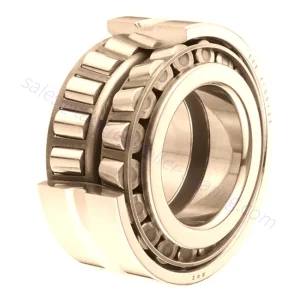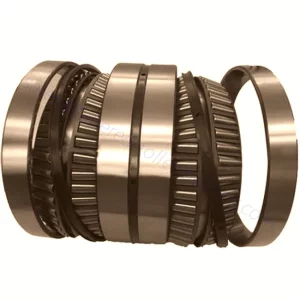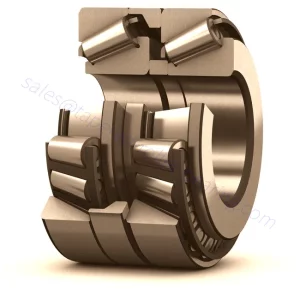Tapered Roller Bearings
Single Row Tapered Roller Bearings
Tapered roller bearings feature a cup and cone assembly. The cup is comprised of the outer ring and the cone assembly consists of inner ring, rollers, and cage. This bearing construction accommodates combined loads and provides low friction during operation. By adjusting one single row tapered roller bearing against a second tapered roller bearing and applying a preload, a rigid bearing application can be achieved.Tapered roller bearings are separable bearings. Both the inner and outer rings of the bearing have tapered raceways. This type of bearing is divided into single row, double row and four row tapered roller bearings according to the number of columns of rolling elements.
The tapered roller bearing is designed so that the apex of the tapered face on the raceway face of the cone cup intersects with a single point on the bearing centerline. Suitable for applications with heavy load and impact load.
As one of the leading tapered roller bearing manufacturers, suppliers, and exporters of mechanical products, We offer tapered roller bearing and many other products.Please get in touch with us for details.
Mail:[email protected]
Single row metric tapered roller bearings are a common type of tapered roller bearings, which are separable. Both the inner and outer rings of the bearing have tapered raceways, and the rollers are in the shape of a truncated cone. The roller and the raceway are in linear contact, which can bear heavier combined radial and axial loads and axial loads. The larger the contact angle, the higher the axial bearing capacity; conversely, the smaller the contact angle, the lower the axial bearing capacity.
The single row metric tapered roller bearing design should extend the contact line between the roller and the inner and outer raceways and then intersect at the same point on the bearing axis for rolling. Single row metric tapered roller shafts mostly use inches.
Single row metric tapered roller bearings application
Single row metric tapered roller bearings are widely used in mining, petroleum, heavy machinery, wind power, engineering machinery, and other industries.
Features and benefits
- Low friction
The optimized roller end design and surface finish on the flange promote lubricant film formation, resulting in lower friction. This also reduces frictional heat and flange wear. In addition, the bearings can better maintain preload and run at reduced noise levels. - Long service life
The crowned raceway profiles of basic design bearings and the logarithmic raceway profiles of bearings optimize the load distribution along the contact surfaces, reduce stress peaks at the roller ends, and reduce the sensitivity to misalignment and shaft deflection compared with conventional straight raceway profiles. - Enhanced operational reliability
The optimized surface finish on the contact surfaces of the rollers and raceways supports the formation of a hydrodynamic lubricant film. - Consistency of roller profiles and sizes
The rollers incorporated in tapered roller bearings are manufactured to such close dimensional and geometrical tolerances that they are practically identical. This provides optimal load distribution, reduces noise and vibration, and enables preload to be set more accurately. - Rigid bearing application
A single row tapered roller bearing is typically adjusted against a second tapered roller bearing. By applying a preload, a rigid bearing application can be achieved. - Running-in period with reduced temperature peaks
Tapered roller bearings typically have a running-in period, during which a conventional design tapered roller bearing experiences a significant amount of friction, resulting in wear. This effect is noticed as a temperature spike. With tapered roller bearing designs, friction, frictional heat, and wear are significantly reduced, provided the bearings are mounted and lubricated correctly. - Separable and interchangeable
The inner ring with roller and cage assembly (cone) can be mounted separately from the outer ring (cup). This facilitates mounting, dismounting, and also maintenance inspection routines. Furthermore, the separable components are interchangeable.




